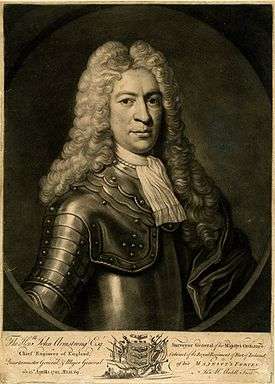John Armstrong (British Army officer)
| John Armstrong | |
|---|---|
 | |
| Born | 31 March 1674 |
| Died | 15 April 1742 (aged 68) |
| Allegiance |
|
| Service/ | British Army |
| Rank | Major-General |
Major-General John Armstrong (31 March 1674 – 15 April 1742) was a British engineer and soldier.
Military career
Armstrong joined the Williamite Army of Ireland in 1691.[1] In 1697 he joined the Duke of Ormonde's Horse Guards.[1]
In August 1711, during the War of the Spanish Succession, he constructed overnight a large battery of artillery with which the enemy was bombarded furiously and successfully in the morning at the Siege of Bouchain.[1]
He was appointed Quartermaster-General to the Forces in 1712 in recognition of his performance at Bouchain.[1] After the Treaty of Utrecht, in Spring 1713, he and Thomas Lascelles were appointed among the Commissioners responsible for overseeing the dismantling of the harbour and fort at Dunkirk.[1]
In 1714, following the accession of George I, he was appointed Chief Engineer.[1] He recommended the split in 1716 of the Ordnance Service into the Royal Engineers and the Royal Artillery.[1]
He was made a Fellow of the Royal Society in 1723.[1]
From 1735 to 1742 he was Colonel of the Royal Regiment of Ireland and promoted Major-General in 1739.[2]
Family
He married Anna Priscilla Burroughs and together they went on to have five daughters.[1] At least two sources provide a lineage showing him to be the great, great, great nephew of the notorious border reiver Johnnie Armstrong.[3] [4]
References
- 1 2 3 4 5 6 7 8 9 John Armstrong at Oxford Dictionary of National Biography
- ↑ Gretton, G. Campaigns and History of the Royal Irish Regiment from 1684 to 1902. p. 426.
- ↑ Betham, William. The Baronetage of England, Vol. V. p. 501.
- ↑ Burke, John. A Genealogical and Heraldic History of the Landed Gentry, Vol. IV. p. 338.
| Military offices | ||
|---|---|---|
| Preceded by New Post |
Quartermaster-General to the Forces 1712–1742 |
Succeeded by Humphrey Bland |
| Preceded by Michael Richards |
Chief Royal Engineer 1714–1742 |
Succeeded by Thomas Lascelles |
| Surveyor-General of the Ordnance 1722–1742 | ||
| Preceded by Sir Charles Hotham, 5th Baronet |
Colonel of the Royal Regiment of Ireland 1735–1742 |
Succeeded by John Mordaunt |